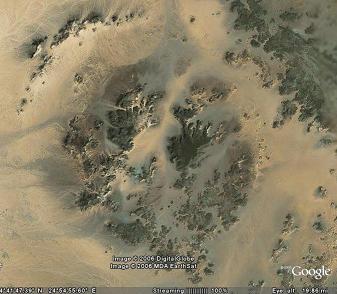Sunday, March 12, 2006
Comet Craters Found with Google Earth
 Emilio Gonzalez found two asteroid craters.
Emilio Gonzalez found two asteroid craters.He didn't use a special satellite, NASA telescope or anything only available to high level scientists. Believe it or not, Emilio began his asteroid impact search with a home computer and a free satellite imaging program called Google Earth.
After reading an article about an asteroid crater in the Middle East called Kebira, Emilio decided to get a closer look at the crater for himself. He launched the Google Earth application and pointed it towards the Egypt/Libya border. Sure enough, after a couple minutes he found the Kebira crater. He studied the shape of the crater and then decided to check out the rest of the area.
After a quick search Emilio located two more craters. Did anyone else know about these craters? He decided to check an earth impact database. But there was no record of them. No one had reported these craters before. Was this really possible? Emilio was still unsure of the validity of his findings and asked a few experts to check out the craters for themselves... Believe it or not, two geologists have confirmed his findings. Emilio actually found two asteroid craters using only Google Earth.
Is it really possible for the average person to make a major scientific discovery using just their home computer? It's hard to believe, but yes.
Emilio was amazed as everyone else was. "It could not be so easy! Was I suffering such excitement that I was seeing impact craters everywhere?" he said.
Just think, Google Earth can make you famous. All it takes is a keen eye and the patience to cross check your findings. Want to follow in Emilio's footsteps? Think you might have found a crater impact? Here's a few tips to help you avoid "crying wolf" with geologists.
1) Make sure you cross check any potential impacts with the impact crater database from the University of New Brunswick, Canada.
2) Avoid confusing asteroid craters with volcanos. According to Fernando Claudin, one of the curators of Impact-Structures.com, "Circularity doesn't mean anything by itself for identifying an impact structure." Anything from a landfill to a volcano could have a circular shape. When searching for asteroid craters, you want the layers of the external ring to be inclined outwards and the internal ring to have a central elevation.
3) Still think you found something? Organize our findings and contact your local geologist.
Good luck.
methodshop
Labels: internet, pics, tech news
Subscribe to Comments [Atom]